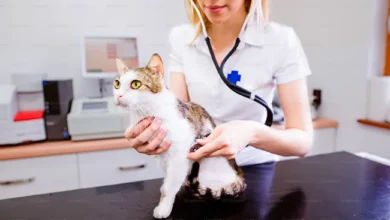
Imagine this: You’re playing fetch with your dog in the backyard or watching your cat chase a laser pointer across the room. Life’s good, right? But then, out of the blue, something goes wrong—maybe your pup takes a bad leap, or your cat isn’t feeling herself. Suddenly, you’re faced with an unexpected vet visit, and the numbers on the bill make your head spin. It’s times like these you find yourself asking, “What does pet insurance cover?”
Pet insurance is like a buddy that’s got your back, financially speaking, when it comes to your pets’ health. Think of it as a buffer against those “Oh no!” moments, ensuring that your furry friend can get the care they need without draining your wallet. The idea is simple: you pay a little each month to avoid a huge bill when something unexpected happens. But, like all insurance, the devil’s in the details. What exactly does pet insurance help with? Accidents, illnesses, check-ups—what’s really on the table?
This guide is here to walk you through all that, breaking down the ABCs of pet insurance in a way that’s easy to grasp. We’re talking about what’s covered, from the no-brainers like accidents and illnesses to the nitty-gritty details of things like genetic conditions or routine care. It’s all about making sure you can make the best choice for your pet, with a clear understanding of the backup plan you’re getting. So, let’s dive in and unravel the mystery of what pet insurance covers, making you a savvy pet parent ready for whatever comes your way.
Understanding Pet Insurance
Definition of Pet Insurance
At its core, pet insurance is a type of insurance policy that pet owners purchase to mitigate the potentially high costs of veterinary care. This form of insurance typically covers a range of medical expenses that might arise due to accidents, illnesses, and sometimes even preventive healthcare for pets like dogs, cats, and occasionally, exotic animals. The principle behind pet insurance is similar to health insurance for humans, albeit with certain differences in terms of policy options, coverage details, and the claims process. In essence, pet insurance offers financial security against unforeseen medical expenses, ensuring that pets receive the necessary care without financial hardship.
Brief History and Evolution of Pet Insurance
The concept of pet insurance is not as modern as some might think. It dates back over a century, with the first known pet insurance policy issued in 1890 in Sweden. This policy was designed for horses and livestock, a testament to the agricultural society’s dependence on animals at the time. However, the first pet insurance policy for a domestic pet was issued in 1924, also in Sweden.
The evolution of pet insurance as we know it today began to take shape in the latter half of the 20th century. Notably, the first pet insurance policy in the United States was issued in 1982 to a very famous dog, Lassie. This marked a significant milestone, opening the doors for the pet insurance industry in the U.S., which has since grown into a multi-billion-dollar sector.
The growth of the pet insurance industry parallels the increasing costs of veterinary care and the growing recognition of pets as family members. Advances in veterinary medicine have expanded treatment options for a variety of conditions, leading to improved health outcomes for pets but also higher costs for their care. As a result, pet insurance has evolved to offer more comprehensive coverage options, including preventive care and chronic condition management, reflecting the changing dynamics of pet ownership and veterinary care.
From its humble beginnings, pet insurance has grown significantly, with numerous providers now offering a variety of plans tailored to meet different needs and budgets. This growth reflects a broader understanding and appreciation of the value of pets in our lives and the lengths to which many are willing to go to ensure their health and well-being.
Read More: The Importance of Dog Insurance and Choosing the Right Policy
Types of Pet Insurance Coverage
Navigating the landscape of pet insurance requires an understanding of the different types of coverage available. Each type serves unique needs, from basic accident protection to comprehensive care that includes wellness and preventive treatments. Let’s explore these types in detail, offering insights into what each coverage entails.
Types of Pet Insurance Coverage
- Accident-Only Coverage
Accident-Only Coverage is precisely what it sounds like—it provides coverage for veterinary treatment related to accidents. This type of insurance is the most basic and generally the least expensive, making it a suitable option for pet owners concerned primarily with sudden, unexpected injuries. Examples of incidents covered under Accident-Only policies include broken bones due to falls, cuts or wounds from accidents, and ingestion of foreign objects requiring emergency surgery. It’s a straightforward protection plan, offering peace of mind for specific, unforeseen events that could lead to significant out-of-pocket costs without insurance.
2. Comprehensive Coverage
Comprehensive Coverage is the most inclusive type of pet insurance, encompassing a wide range of veterinary care expenses. Beyond just accidents, this coverage extends to illnesses, surgeries, diagnostic tests, hospital stays, and even emergency care. It’s designed for pet owners seeking a broad safety net for both unpredictable accidents and the myriad health issues pets can encounter over their lifetimes, from common illnesses like ear infections to complex conditions like cancer or diabetes.
Comprehensive policies may also cover treatments for hereditary and congenital conditions, which are particularly valuable for certain breeds prone to specific health issues. Moreover, some plans include coverage for alternative therapies, such as acupuncture or chiropractic treatment, offering a holistic approach to pet health care. Given its extensive coverage, comprehensive insurance is typically more expensive than Accident-Only policies but provides an unparalleled level of financial security and care options.
3. Wellness and Preventive Care
Wellness and Preventive Care coverage focuses on maintaining the health of pets through routine care rather than treating illness or injuries after they occur. This type of insurance can be purchased as a standalone policy or as an add-on to a comprehensive plan. Coverage typically includes vaccinations, annual check-ups, flea and tick prevention, heartworm medication, teeth cleaning, and spaying/neutering.
The rationale behind Wellness and Preventive Care is proactive health management—by regularly monitoring and maintaining your pet’s health, you can prevent diseases and catch potential health issues early, potentially reducing the need for more expensive treatments down the line. While this type of coverage does not cater to unexpected health emergencies, it plays a crucial role in ensuring the long-term health and well-being of pets, making it an essential consideration for responsible pet ownership.
What Is Typically Covered
Diving into the specifics of what pet insurance typically covers illuminates the breadth of protection these policies can offer. From sudden accidents to chronic conditions, the right insurance plan can provide comprehensive coverage that eases financial burdens and enhances care. Let’s break down these coverage areas with expert insights.
What Is Typically Covered
- Accidents and Injuries
Accidents and injuries are the pillars of most pet insurance policies. Coverage typically includes the treatment of broken bones from falls or collisions, lacerations from unexpected mishaps, and injuries from vehicular accidents. Poisonings and bite wounds from other animals are also commonly covered. These policies are designed to manage the costs of unforeseen accidents that can happen in the blink of an eye, ensuring that your pet gets the necessary care without delay.
2. Illnesses
Illness coverage is a critical component, addressing everything from minor ailments like ear infections and gastrointestinal upsets to serious conditions such as cancer, heart disease, and diabetes. Chronic illnesses, which require ongoing management over a pet’s lifetime, are also covered under most comprehensive plans. This aspect of pet insurance is invaluable for maintaining the health and quality of life of pets with long-term medical needs.
3. Surgical Procedures
Surgical procedure coverage spans a wide range, including both emergency and elective surgeries. Emergency surgeries might be needed for acute conditions like intestinal blockages or traumatic injuries, while elective surgeries can include spaying/neutering or dental surgeries. The inclusion of surgery coverage in a pet insurance plan ensures that pets have access to life-saving or quality-of-life improving procedures when needed.
4. Diagnostic Tests
Understanding what ails your pet often requires diagnostic testing, and pet insurance typically covers a broad array of these tests. This includes blood work, urinalysis, X-rays, MRIs, and CT scans. These tools are essential for accurate diagnosis and formulating effective treatment plans, representing a significant portion of veterinary care costs.
5. Prescription Medications
Prescription medications are frequently needed for both acute and chronic conditions, and most pet insurance policies cover these costs. This includes antibiotics, pain relief medications, and ongoing prescriptions for chronic conditions such as heart disease or thyroid imbalances.
6. Emergency Care
Emergency care coverage is critical for situations that require immediate medical attention, such as accidents, poisoning, or acute illnesses. This includes visits to emergency clinics or veterinary hospitals, where the cost of care can be significantly higher due to the urgency and complexity of treatment required.
7. Genetic Conditions
Breed-specific genetic conditions can be a major concern for certain pets, and many insurance policies offer coverage for these conditions. This includes hereditary disorders like hip dysplasia in dogs, polycystic kidney disease in cats, and other genetic anomalies. Coverage for genetic conditions is particularly important for owners of breeds known to have specific health risks.
8. Alternative Therapies
Increasingly, pet insurance is recognizing the value of alternative therapies in treating a variety of conditions. This can include acupuncture, chiropractic care, physiotherapy, and hydrotherapy, among others. These treatments can be particularly beneficial for chronic pain management, recovery from surgery, or enhancing mobility in older pets.
What Is Not Covered
Understanding what is not covered by pet insurance is as crucial as knowing what is covered. This clarity helps pet owners set realistic expectations and plan accordingly for their pet’s healthcare needs. Let’s delve into the typical exclusions found in pet insurance policies, providing expert insights into each area.
What Is Not Covered
- Pre-existing Conditions
A pre-existing condition refers to any illness or injury that a pet has before the start or during the waiting period of an insurance policy. These conditions are not covered by pet insurance because the policy is intended to mitigate the risk of unforeseen medical expenses, rather than those already known to the pet owner and the insurance provider. The rationale behind this exclusion is to prevent the insurance system from being overwhelmed by the costs of conditions that were already present and potentially expensive to treat. However, some insurance providers may cover curable pre-existing conditions after a certain period of time without symptoms or treatment, but this varies by policy.
2. Routine and Preventive Care
Routine and preventive care includes vaccinations, annual check-ups, flea and tick preventatives, dental cleanings, and spaying/neutering. These are typically not covered by standard pet insurance policies, which are designed to protect against unexpected illnesses and emergencies. However, many insurance providers offer wellness plans as separate, add-on options that specifically cover these preventive measures. It’s important for pet owners to understand the distinction between emergency coverage and wellness coverage to budget accordingly for their pet’s healthcare needs.
3. Specific Breed Exclusions
Some pet insurance policies may have exclusions or limitations for specific breeds that are known to have a high risk of hereditary or congenital conditions. For example, certain dog breeds like Bulldogs, German Shepherds, and Great Danes may be prone to specific health issues that can lead to higher veterinary costs. Insurance companies might limit coverage or charge higher premiums for these breeds to offset the increased risk. Pet owners should research and compare insurance options carefully to find coverage that best fits their pet’s breed-related needs.
4. Behavioral Issues
Coverage for behavioral consultations and treatments is often limited or excluded in pet insurance policies. Behavioral issues might include aggression, separation anxiety, and compulsive behaviors. While these are significant concerns for pet owners, they are typically not covered because they are considered preventable or manageable through training rather than medical intervention. However, the landscape is changing, and some newer policies are beginning to offer coverage for behavioral treatments, recognizing their importance in a pet’s overall health and well-being. Pet owners interested in this coverage should look for specific plans that include behavioral health or ask providers about available options.
Understanding Policy Terms
Navigating the intricacies of pet insurance requires a clear understanding of policy terms. These terms dictate the coverage scope, costs involved, and when the coverage takes effect, playing a crucial role in how beneficial the policy is for both the pet and the owner. Let’s explore these essential elements to demystify the terms commonly found in pet insurance policies.
Understanding Policy Terms
Deductibles
The deductible is the amount that the pet owner must pay out-of-pocket before the insurance company starts covering the cost of veterinary care. Deductibles can vary widely between policies and can be charged per incident, per year, or even per condition, depending on the insurer’s terms. Choosing a higher deductible can lower the monthly premium but means paying more upfront when care is needed. Conversely, a lower deductible increases the premium but reduces the cost burden when making a claim. Understanding how deductibles work is vital for selecting a policy that aligns with your financial ability to pay upfront costs.
Premiums
Premiums are the monthly or annual payments made to keep the pet insurance policy active. Various factors influence premium rates, including the pet’s age, breed, and the area where the pet lives, as these can affect the likelihood of health issues and the cost of veterinary care. The chosen deductible, reimbursement level, and the scope of coverage (accident-only vs. comprehensive) also play a significant role in determining the premium. Insurance companies may also adjust premiums based on the pet’s health history and the overall claim history of insured pets, reflecting the risk and cost of providing coverage.
Coverage Limits
Coverage limits are the maximum amounts an insurance policy will pay out for covered expenses. These limits can be imposed annually, per incident, or over the pet’s lifetime. Annual limits reset each policy year and can range from a few thousand dollars to unlimited coverage, affecting the premium cost. Per-incident limits cap the amount available for a specific condition or event, while lifetime limits are the total amount the policy will pay out over the pet’s life. Selecting a policy with adequate coverage limits is crucial to avoid unexpected out-of-pocket expenses for major medical issues.
Waiting Periods
Waiting periods are the time frames between the start of the policy and when the coverage becomes effective. These periods prevent claims for conditions that occur immediately after obtaining a policy, mitigating the risk of covering pre-existing conditions. Waiting periods vary by insurer and can differ for accidents, illnesses, and specific conditions. For example, a policy might have a 14-day waiting period for illnesses but only a 48-hour period for accidents. Understanding the waiting periods helps manage expectations and planning, especially when switching policies or enrolling in a new one.
Choosing the Right Pet Insurance
Selecting the right pet insurance policy is a critical decision that can significantly impact your pet’s health care and your financial well-being. It requires careful consideration of several factors to ensure that the chosen policy meets your pet’s needs and aligns with your expectations. Let’s explore the key steps in choosing the right pet insurance.
Choosing the Right Pet Insurance
Assessing Your Pet’s Needs
The first step in selecting a pet insurance policy is to evaluate your pet’s specific needs, which are influenced by their age, breed, and current health status. Younger pets may require a different focus, emphasizing preventive care and vaccinations, while older pets might benefit more from comprehensive coverage that includes chronic conditions and emergency care. Breed-specific considerations are crucial, as some breeds are predisposed to certain health issues that can require specialized treatment. Assessing these factors will help you determine the type and scope of coverage that best suits your pet.
Comparing Providers
With numerous pet insurance providers in the market, comparing their offerings can be daunting but essential. Focus on the coverage options, exclusions, and costs. Look beyond the basic premium and deductible amounts to understand the coverage limits, reimbursement levels, and any breed-specific exclusions or age limitations. Additionally, compare how different providers handle pre-existing conditions and the flexibility of their policies, such as the ability to choose your vet or specialist.
Reading the Fine Print
Understanding the terms and conditions of any insurance policy is vital before making a commitment. This includes knowing what is covered and what is not, the details surrounding deductibles and coverage limits, and any specific requirements or exclusions that could affect your claims. Pay special attention to the waiting periods for different types of coverage and how the policy addresses the renewal process, particularly if your pet has received care for any conditions during the previous term.
Customer Reviews and Ratings
Customer feedback can be a valuable resource in evaluating the reliability and service quality of an insurance provider. Reviews and ratings often highlight real-world experiences with filing claims, customer service interactions, and the overall satisfaction of other pet owners. Look for patterns in feedback, both positive and negative, to gauge the insurer’s responsiveness, ease of claim processing, and transparency. However, take individual reviews with a grain of caution and look for a consensus among multiple sources.
Conclusion
Recap of the Importance of Pet Insurance
Pet insurance stands as a testament to the lengths we are willing to go to ensure our pets live long, healthy lives. It acknowledges the unpredictable nature of health care—be it for humans or our pets. The essence of pet insurance is not just about mitigating the financial impact of veterinary expenses; it’s about removing barriers to the best possible care for our beloved animals. Through its coverage, pet insurance enables us to make medical decisions based on what is most beneficial for our pets’ health, rather than being constrained by cost considerations.
Encouragement to Consider Pet Insurance as an Investment in Your Pet’s Health and Well-Being
Viewing pet insurance as an investment rather than an expense shifts the perspective to see the true value it brings. This investment safeguards not only against unexpected veterinary costs but also invests in the well-being and longevity of our pets. It is an expression of our commitment to their health, ensuring that they receive necessary medical care promptly and without compromise.
The decision to invest in pet insurance is a reflection of the deep bond we share with our pets. It acknowledges that they are not just animals living in our homes but cherished family members whose health and happiness are intertwined with our own. In this light, pet insurance becomes a cornerstone of responsible pet ownership, enabling us to fulfill our commitment to their well-being through every stage of their lives.
In conclusion, as we navigate the complexities of pet health care, let pet insurance be the tool that empowers us to provide the best possible life for our furry family members. It is a choice that underscores our dedication to their well-being, ensuring that when faced with health challenges, we are prepared to support them with the care and treatments they deserve.



